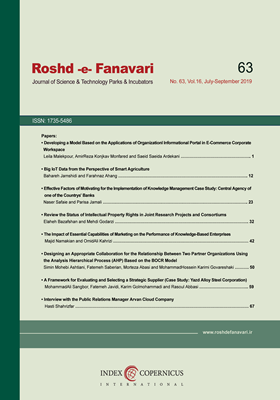Designing an Appropriate Collaboration for the Relationship Between Two Partner Organizations Using the Analysis Hierarchical Process (AHP) Based on the BOCR Model
Subject Areas : Innovation and Inventionmorteza abasi 1 , simin mohebbi ashtiani 2 , mohammad hossein karimi 3 , fatemeh saberian 4
1 -
2 -
3 -
4 -
Keywords: Collaboration Patterns BOCR Model Analysis Hierarchical Process (AHP),
Abstract :
Today, as global competition in the business world grows, companies need to have a close relationship with their suppliers in order to survive and achieve reasonable profits. Researchers have recently examined some models for supplier selection, with less attention to the determination of collaboration pattern with selected partners. Despite much research on the types of collaboration models, their features, requirements and achievements, providing a comprehensive and uppropriate model for selecting the most appropriate type of relationship between the two partner organizations has not been sufficiently considered. Generally, supplier-buyer collaboration patterns include outsourcing, strategic alliance, joint investment and ownership. The purpose of this research is to design a model that determines the appropriate collaboration model according to the product characteristics, business conditions and goals of the organization. The model uses profit, opportunity, cost and risk structure, which is a comprehensive and useful model for strategic decisions. In this research, the choice of collaboration model between two partner organizations is investigated in order to design radar components. By library study and interviewing with the experts of the Iranian Defense Industry Organization, the factors influencing the selection of the appropriate cooperation model for the relationship between the two partner organizations were identified and prioritized. A Hierarchical Analysis Process Model (AHP) is designed to prioritize the relevant criteria and sub-criteria. Pairwise comparisons were made according to the experts' opinion and the results were analyzed using SuperDisign software.
1- الفت، لعيا.؛ براتي، مسعود.؛ ولدی، محمدرضا،" چارچوبي برای تصميم برونسپاری راهبردی، مطالعه موردی: تعيين راهبردهای تأمين مجموعههای توليدی بدنه خودرو سمند"، فصلنامه علمي پژوهشي مطالعات مدیریت صنعتي، سال نهم، شماره 25، تابستان 91، صص 27-50، 1391.
2- ابراهیمی، مهدی؛ رحمان سرشت، حسین، شراکت راهبردی، تهران، انتشارات علامه طباطبایی، 1393.
3- Amy H. I. Lee, A fuzzy AHP evaluation model for buyer–supplier relationships with the consideration of benefits, opportunities, costs and risks, International Journal of Production Research, 47:15, 4255-4280, 2007.
4- Cheisa, v "R&D Strategy and Organizaton. managing technical change in dynamic context", Imperial College press, 2001.
5- Hoffmann, W.H. and Schlosser, R., Success factors in strategic alliances in small and mediumsized enterprises – an empirical survey. Long Range Planning, 34, 357–381, 2001.
6- Dacin, M.T. and Hitt, M.A., Selecting partners for successful international alliances: examination of U. S. and Korean firms. Journal of World Business, 32 (1), 3–16, 1997.
7- Chen, C. J., The effects of environment and partner characteristics on the choice of alliance forms. International Journal of Project Management, 21, 115–124, 2003.
8- Townsend, J. D., Understanding alliances: a review of international aspects in strategic marketing. Marketing Intelligence & Planning, 21 (3), 143–156, 2003.
9- Yasuda, H. and Iijima, J., Linkage between strategic alliances and firm’s business strategy: the case of semiconductor industry. Technovation, 25, 513–521, 2005.
10- Das, T. K. and Teng, B.- S., Partner analysis and alliance performane. Scandinavian Journal of Management, 19, 279–308. 2003.
11- Murray, J.Y., Kotabe, M., and Zhou, J.N., Strategic alliance-based sourcing and market performance: evidence from foreign firms operating in China. Journal of International Business Studies, 36, 187–209, 2005.
12- Gill, C. Liestmann V. and Bleck, S. Strategisches Management von Unternehmenskooperationen (Strategic management of corporate cooperations) In: Luczak, H.; Schenk, M.: (Cooperation in theory and practice. Human, organizational and legal aspects of cooperation in industrial services of ..., Dusseldorf: VDI Publishing House, pp. 257-270, 1999.
13- Whipple, J. M. and Frankel, R., Strategic alliance success factors. Journal of Supply Chain Management, 36 (3), 21–28, 2000.
14- Todeva, E. and Knoke, D., Strategic alliances and models of collaboration. Management Decision, 43 (1), 123–148, 2005.
15- Wheelen, T. L. and Hungar, D.J., Strategic Management and Business Policy. New York: Addison- Wesley, 2000.
16- Zineldin, M. and Bredenlow, T., Strategic alliance: synergies and challenges: a case of strategic outsourcing relationship ‘SOUR’. International Journal of Physical Distribution & Logistics Management, 33 (5), 449–464, 2003.
17- Zineldin, M. and Jonsson, P., An examination of the main factors affecting trust/commitment in supplier– dealer relationships: an empirical study of Swedish wood industry. The TQM Magazine, 12 (4), 245–65, 2000.
18- Malott, R. H., Managing the global enterprise. Executive Speeches, 7 (4), 6–10, 1992.
19- Michelet, R. and Remacle, R., Forming successful strategic marketing alliance in Europe. Journal of European Business, 4 (1), 11–15, 1992.
20- Soursac, T, When the hub spoke. The Alliance Analyst, 1–4 , 1996. [online]. Available from: http://www.allianceanalyst.com [Accessed 30 January 2007],
21- Elmuti, D. and Kathawala, Y., An overview of strategic alliances. Management Decision, 39 (3), 2005–2017. 2001.
22- Kalmbach Jr, C. and Roussel, C., Dispelling the myths of alliances. Outlook, October, 5–32. 1999.
23- Amy H.I. Lee, Hsing-Jen Chang, Chun-Yu Lin, An evaluation model of buyer–supplier relationships in high-tech industry. Computers & Industrial Engineering ,57, 1417–1430, 2009.
24- Saaty, R.W., 2003. Decision making in complex environment: the analytic hierarchy process (AHP) for decision making and the analytic network process (ANP) for decision making with dependence and feedback. Pittsburgh, PA: Super Decisions.
25- Saaty, T.L., Theory and applications of the analytic network process: Decision making with benefits, opportunities, costs, and risks. Pittsburgh, PA: RWS Publications, 2005.
26- Saaty, T.L. and Ozdemir, M., Negative priorities in the analytic hierarchy process. Mathematical and Computer Modelling, 37, 1063–1075, 2003.
27- Erdogmus, S., Kapanoglu, M., and Koc, E., Evaluating high-tech alternatives by using analytic network process with BOCR and multiactors. Evaluation and Program Planning, 28, 391–399. 2005.


